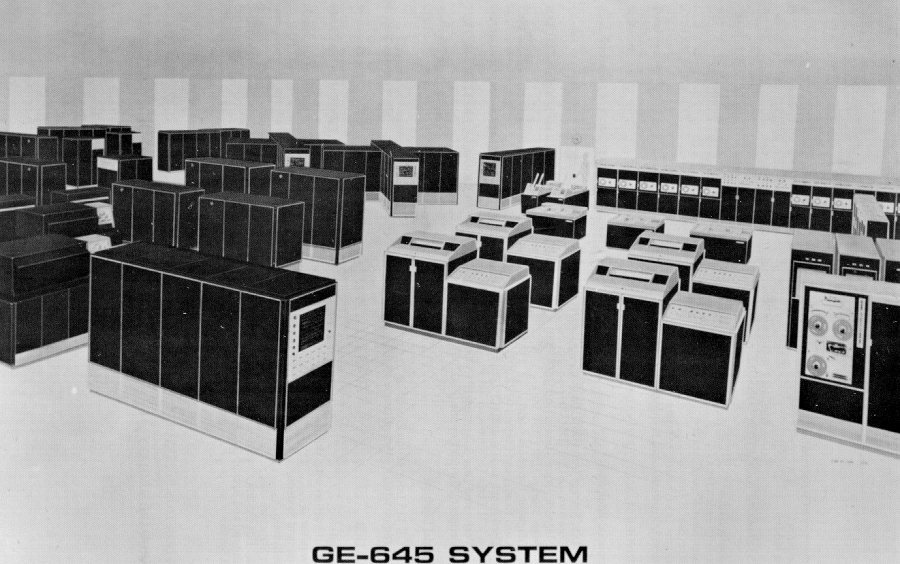GE-645 Multics System, Artist's Rendition

Photo credit: General Electric Information Systems Equipment Division, 1968
Initial M.I.T. Multics System configuration, 1967-1972:
Equipment: General Electric model GE-645
- 2 processors, each about 435,000 instructions/second
(technology: discrete transistors)
- 3 Memory boxes, each about 1 Mbyte (organized as 36-bit words)
(technology: core memory, 1 microsecond access time)
- Librafile swapping drum, 16 Mbytes
- 2 General I/O controllers
- 2 disk systems, total of 136 Mbytes of disk in 10 Mbyte modules
- Tape drives, card reader, etc.
- Terminals attached directly and via 300 b/s modems:
- IBM 2741
- IBM 1050
- TTY 35 and 37
- ARDS experimental display
- ARPANet attachment, circa 1971
Performance: In the Spring of 1970, about six months after the
Multics system was first made available for public use, it was
providing satisfactory response to 35 simultaneous time-sharing
users.
The hardware was upgraded in 1972 to processors that were about
twice as fast, and the number of users increased accordingly; the
system, with further upgrades, continued in production operation at
M.I.T. until 1988. Over the lifetime of the system, 82 different
sites ran Multics systems. One of the largest commercial
configurations, at General Motors Corporation in Detroit, was configured
with up to six processors, had over 17,000 registered users, and
could handle 200 simultaneous users.
Innovations
Multics was most notable for the large number of ideas brought
together into a single system. Although many of these features had
been tried in one or another system, often on an experimental basis,
no one had previously attempted to integrate all these ideas into a
single production system. Most modern systems can trace their
versions of these features directly back to Multics, often via UNIX,
which was a direct outgrowth of the Bell Telephone Laboratories
participation in the Multics project design. As one example of an
idea not transmitted via UNIX,, the one-level store programming
interface was picked up directly from Multics by Prime Computer
Primos, Stratus Computer VOS, Apollo Domain, Nippon Telephone DIPS,
IBM TSS/360, System 38, and AIX, and Livermore's Amber for the
S-1.
Operating system: Integrated concepts and innovations
- Hierarchical file system
- Long file names
- Relative and absolute path names
- Working directory
- Access control lists
- Symbolic links
- Incremental backup
- Disk salvaging
- Quota management
- Programming interface
- One-level store with shared memory segments
- Supervisor interface is atomic
- Dynamic linking of programs
- Library search rules
- Multiple, interoperable programming languages
- Supervisor operates in virtual memory and runs in user mode
- 3-level virtual memory
- Resource usage accounting
- Command language interface (user-replaceable shell)
- Recursive command composition (active functions)
- Shell scripts
- wild-cards in command arguments
- absentee script execution
- Device-independent input and output
- Standard input and output streams
- Switchable I/O streams
- Virtual teletype
- Multiple processor support
- Symmetric multiprocessor management
- Threads
- Interprocess communication and coordination
- Dynamic reconfiguration of hardware
- Daemons for background system functions
- User interface
- Upper and lower case character set
- Word processing and formatting
- Electronic mail
- Non-Discretionary Access Control, B2 security rating
Hardware innovations
- Memory segmentation and paging
- Translation lookaside buffer
- Rings of protection
- General I/O controller
- Time-of-century clock
System development innovations
- Use of a time-sharing system for system development
- Use of a file system for system source programs
- Higher-level language for system implementation
- Policy that documentation precedes implementation
- Policy that the designer does the implementation
- Policy of design review before debugging begins
- Built-in system instrumentation for immediate feedback
- Small modules with frequent design iteration
- Daily complete system rebuilds
A more extensive list of features can be found in the paper by
F. J. Corbato, Jerome H. Saltzer, and Charles T. Clingen, Multics--the first seven
years,
AFIPS Conf. Proc 40 (1972 Spring Joint Computer Conference) AFIPS Press,
1972, pages 571-583.
The material on this page was assembled by J. H. Saltzer
from several sources:
- his personal files
- the personal files of F. J. Corbató
- Thomas Van Vleck's World Wide Web
collection
of Multics memorabilia
Posted: May 1996. Last revised: January 2004.
Comments and questions: Saltzer@mit.edu
